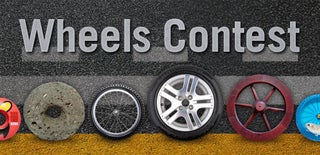Introduction: Biga, the Bike Trailer
In support of a bicycle workshop I have decided with my friends to build a trailer to carry the tools around the city.
We were not skilled in welding iron frames, but that didn't stop us, and with some advice we succeeded in building a nice, strong, and effective trailer, which remembers me an ancient Roman "biga".
[first two pictures are created with pixlr express]
Step 1: The Pieces
We started to cut an old and cheap mountain bike frame, so that we had different measures tubes. As wheels I found a pair of children bike forks, so to have an easy wheel connection and to use 20" wheels, not big as 26" but not as tiny as a cart. The green tube comes from another old bike frame, it has an elliptical section, and it matches very well with forks' heads.
Step 2: The Project
As you see the project is quite simple. The forks are horizontal and connected by two little pipes. All this acts as a surface plane, where we will link the toolbox. The main problem in a frame like this is to avoid big leverages on the weld joints, and I planned to stiffen the structure with diagonal pipes for both longitudinal and cross direction. In this way the weak part is the middle section of the vertical pipe, but it proved to be strong enough.
Step 3: The Hitch
The joint has to link generally the bike to the trailer leaving the three axis free to rotate. This is not true if the trailer has only one wheel, indeed in that case the longitudinal axis rotation has to be held by the bike.
We used a kick scooter front part, which appeared to be so perfect for that purpose. Indeed the ring attached in place of the wheel will be coaxial to the seat tube, and both vertical and transverse rotation axis don't add any torsion on the seat post. The scooter steering wheel mechanism acts to freeing the last longitudinal axis rotation, although it's not in the exact horizontal direction. Indeed the three rotation axis need to be not aligned, but not exactly perpendicular one to each other. As you will see in the next animation this tilted axis will help to steer.
Step 4: Final Design
The 3D model came out pretty nice, and I was able to make a 3D animation, from which is clear how the trailer behaves during a turn. The bike and the seat post will tilt around the longitudinal axis, the trailer tries to follow it, but since the longitudinal axis rotation is linked to the vertical axis one, it's imposed to also move toward the inner side. That results practically in a much easy turn and better stability, at both high and low speed.
[click on the image to see a better quality animation]
Step 5: Shaping the Tubes
With the angle grinder refine the tubes' heads so that they match with the adjacent pipe section. This will help to make a better weld.
Step 6: The Welding
This is the fun part. With the shielded metal arc welding machine link the tubes together, trying not to pierce them. That will be difficult since the bike frames have usually tubes with thin sections. We used 2.5mm electrodes, but you can probably try with smaller ones. As I said we are not welding masters, actually I'm the exact opposite ;-)
Step 7: Remove Slag
With the right tool remove the slag from the weld, beat it hardy and check that all the edge is well welded. If not put your mask on again and weld the weak sections with more material.
Step 8: Welding Completed
The welding part is completed and at full night we can finally carry the trailer home (we made it at the bike workshop). A real satisfaction, especially after the discover that the feeling is to have nothing to pull. Indeed the trailer is also light and very fluid in movement, with a very low center of gravity, especially if unloaded.
Step 9: Some Finishing
The ugly welding joints need some finishing. So I added a thick layer of two components plaster, I left it dry and then I smoothed it with file and sand paper. Not the best work, but actually the full trailer has many imperfections, and we didn't want to put too much time in this.
Step 10: The Tail Light
To build the tail light I searched a plastic cap which exactly fits on the extremity of the trailer horizontal pipe. I removed a bike LED light from its silicon case. Then I glued the edge if the light inside the cap. Pushing the transparent shell you can easily turn on and off the red light.
Step 11: Painting
With the painting process the trailer arises in all its beauty and (im) perfection ;-)
We painted the frame with a white spray paint, then we added light (which was not so cool) and dark blue layers. We opted for an ochre tint for the kicker scooter joint. Paint on the rotation joint doesn't affect its behavior, but you ought to cover the seat tube ring, so to handle it without ruin the paint.
Obviously two components paints are much more resistant to scratches and abrasions, I really suggest to use them instead of the classic spray cans.
Step 12: Assembling
Now you can assemble the joint using a fast saddle clasp or bolt and nut. Then put the wheels on and insert the tail light in the tube. Don't glue the light, since you need to remove it to change batteries.
Step 13: Adding Toolbox
The toolbox should stay between wheels, over the two small tubes. Keep that in mind when you design the trailer dimensions. You can lock the box with a belt, or trying a smart method as illustrated in next step.
Step 14: Fasten the Box
To fasten the box to the frame you can use four broom holders like ones in the pictures. Attach them under the box so that they hang the forks in the positions shown in the first photo, the toolbox should now stay firm in every direction. I still have to attach mines.
As you can see the toolbox can be opened still on the trailer. Anyway, with an easy and fast method to secure it, as the broom holders are, you can lift the box and remove it from the frame. The holders will act also as rubber feet.
Step 15: Ride Your Bike and Biga
Your trailer is ready, secure it to your bike removing the seat post and inserting it on the pivot ring. If the ring moves up and down along the seat post you can add a nylon band on the seat tube.
The biga carried a person (about 65 Kg) for 20 Km with no difficulty so it's sturdy enough to carry heavy loads too.
It's time to enjoy it, but remember to avoid vehicular roads, it's certainly not the safer vehicle to drive on them.

Runner Up in the
Wheels Contest

Participated in the
Metal Contest














